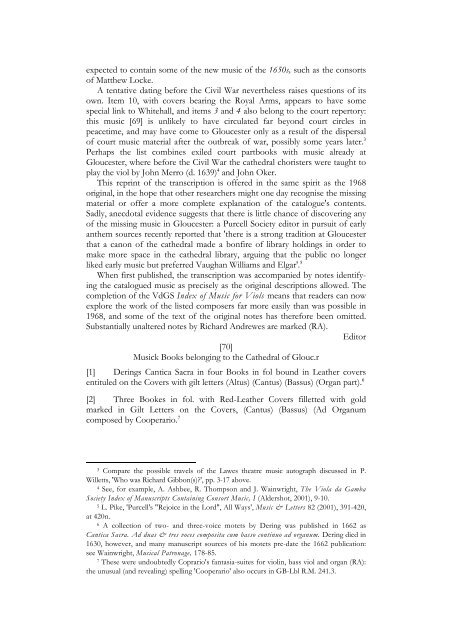download.pdf - 1.2Mb - Viola da Gamba Society
download.pdf - 1.2Mb - Viola da Gamba Society
download.pdf - 1.2Mb - Viola da Gamba Society
You also want an ePaper? Increase the reach of your titles
YUMPU automatically turns print PDFs into web optimized ePapers that Google loves.
expected to contain some of the new music of the 1650s, such as the consorts<br />
of Matthew Locke.<br />
A tentative <strong>da</strong>ting before the Civil War nevertheless raises questions of its<br />
own. Item 10, with covers bearing the Royal Arms, appears to have some<br />
special link to Whitehall, and items 3 and 4 also belong to the court repertory:<br />
this music [69] is unlikely to have circulated far beyond court circles in<br />
peacetime, and may have come to Gloucester only as a result of the dispersal<br />
of court music material after the outbreak of war, possibly some years later. 3<br />
Perhaps the list combines exiled court partbooks with music already at<br />
Gloucester, where before the Civil War the cathedral choristers were taught to<br />
play the viol by John Merro (d. 1639) 4 and John Oker.<br />
This reprint of the transcription is offered in the same spirit as the 1968<br />
original, in the hope that other researchers might one <strong>da</strong>y recognise the missing<br />
material or offer a more complete explanation of the catalogue's contents.<br />
Sadly, anecdotal evidence suggests that there is little chance of discovering any<br />
of the missing music in Gloucester: a Purcell <strong>Society</strong> editor in pursuit of early<br />
anthem sources recently reported that 'there is a strong tradition at Gloucester<br />
that a canon of the cathedral made a bonfire of library holdings in order to<br />
make more space in the cathedral library, arguing that the public no longer<br />
liked early music but preferred Vaughan Williams and Elgar'. 5<br />
When first published, the transcription was accompanied by notes identifying<br />
the catalogued music as precisely as the original descriptions allowed. The<br />
completion of the VdGS Index of Music for Viols means that readers can now<br />
explore the work of the listed composers far more easily than was possible in<br />
1968, and some of the text of the original notes has therefore been omitted.<br />
Substantially unaltered notes by Richard Andrewes are marked (RA).<br />
Editor<br />
[70]<br />
Musick Books belonging to the Cathedral of Glouc.r<br />
[1] Derings Cantica Sacra in four Books in fol bound in Leather covers<br />
entituled on the Covers with gilt letters (Altus) (Cantus) (Bassus) (Organ part). 6<br />
[2] Three Bookes in fol. with Red-Leather Covers filletted with gold<br />
marked in Gilt Letters on the Covers, (Cantus) (Bassus) (Ad Organum<br />
composed by Cooperario. 7<br />
3 Compare the possible travels of the Lawes theatre music autograph discussed in P.<br />
Willetts, 'Who was Richard Gibbon(s)?', pp. 3-17 above.<br />
4 See, for example, A. Ashbee, R. Thompson and J. Wainwright, The <strong>Viola</strong> <strong>da</strong> <strong>Gamba</strong><br />
<strong>Society</strong> Index of Manuscripts Containing Consort Music, I (Aldershot, 2001), 9-10.<br />
5 L. Pike, 'Purcell's "Rejoice in the Lord", All Ways', Music & Letters 82 (2001), 391-420,<br />
at 420n.<br />
6 A collection of two- and three-voice motets by Dering was published in 1662 as<br />
Cantica Sacra. Ad duas & tres voces composita cum basso continuo ad organum. Dering died in<br />
1630, however, and many manuscript sources of his motets pre-<strong>da</strong>te the 1662 publication:<br />
see Wainwright, Musical Patronage, 178-85.<br />
7 These were undoubtedly Coprario's fantasia-suites for violin, bass viol and organ (RA):<br />
the unusual (and revealing) spelling 'Cooperario' also occurs in GB-Lbl R.M. 241.3.
















